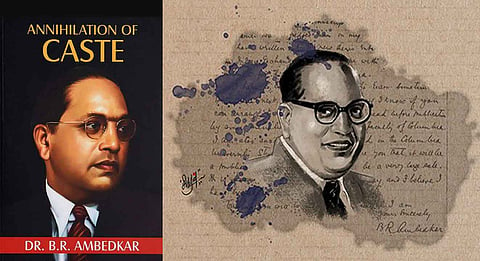
New Delhi- A few days ago, while sipping chai at Mandi House, I overheard a conversation between a ragpicker woman and the chaiwala. To my surprise, they were using terms like "Chuhra" and "Chamar" to refer to a third person. This encounter brought to mind a quote by Dr. Ambedkar on the social hierarchy: "Caste is not merely a division of labor but the division of laborers too." This experience led me back to the academic debates surrounding the caste hierarchy, particularly in the context of Dr. Ambedkar's views, theories, and remedies for persistent graded inequality.
This article delves into Dr. Ambedkar's thoughts on persistent graded inequality. To be precise, caste is not simply a social evil; it is a hierarchy, a system of graded inequality. As students of Phule and Babasaheb Ambedkar, we must refrain from attributing an unscientific character to caste.
Dr. Ambedkar's insights, articulated at gatherings in Mahad, Yeola, and Nasik, were the result of his deep theoretical and practical knowledge. He extensively wrote on various social issues, including the origins of untouchability, the caste system, religion, state, economy, agrarian development, and women's issues. His political philosophy is dynamic, adaptable, and relevant across generations.
He posited that caste is a notion and a state of mind. To annihilate the caste system, there must be a change in perception. His seminal work "Castes in India, Their Mechanism, Genesis and Development," penned in 1917, explores the probable origins of the caste hierarchy.
According to him, while classes existed universally, India saw the refusal of social mobility, intermarriage, and interdining by certain priestly classes, leading to the formation of self-enclosed categories like castes. Endogamy perpetuated these divisions, eroding social mobility and solidifying birth-based identities. The caste system, reinforced by notions of purity and pollution rooted in Hindu texts, imposed inhumane practices to maintain its sanctity, perpetuated by imitation among sub-castes.
Dr. Ambedkar's arguments diverged from those of other nationalist thinkers regarding the caste system. He emphasized the need to eliminate birth-based and socio-economic inequalities. While many ignored existing social disparities, untouchability remained legal in pre-independent India, primarily practiced by the Savarnas. Even self-proclaimed progressives in intellectual circles neglected discussions on the caste system.
In his work "The Untouchables: Who Were They and Why They Became Untouchables?" published in 1948, Dr. Ambedkar elucidates the probable origins of practices like untouchability. He theorizes that untouchables were the "Broken Men," defeated in tribal wars, left isolated and alienated. As settled communities feared nomadic tribes, agreements were struck for protection, leading to the emergence of untouchability, purity, and pollution.
While debatable, Dr. Ambedkar's historical approach to untouchability was influential. His political philosophy evolved, reflecting changes in societal issues. Initially theorizing the caste's origins, he later addressed untouchability, the backbone of the caste hierarchy.
In his seminal work "Annihilation of Caste," intended for the Jat Pat Todak Mandal in 1936, Dr. Ambedkar advocated radical solutions. He realized that mere intermarriage and interdining were insufficient to eradicate the caste system. Instead, he called for a rejection of Dharma shastras, smritis, and Vedas to break Brahmanical hegemony. Skeptical of reforms within Hinduism, he proposed abolishing priesthood and promoting social mobility based on merit, not birth.
Dr. Ambedkar's concept of "social endosmosis," emphasizing assimilation of multicultural values and mutual respect, remains influential. He envisioned a society based on liberty, equality, and fraternity, free from socio-economic disparities. Despite advocating democratic values, he critiqued democracy's compatibility with the caste system in India. His vision was a nation where all oppressed sections would be emancipated.
In his encounter with M.K. Gandhi, Dr. Ambedkar stated, "Gandhiji, I have no homeland." This search for homeland, initiated by Babasaheb Ambedkar, persists today.
- Aniket Gautam is a final-year student in the Department of Political Science at Zakir Husain Delhi College, Delhi University.
You can also join our WhatsApp group to get premium and selected news of The Mooknayak on WhatsApp. Click here to join the WhatsApp group.